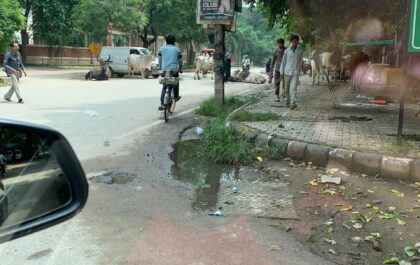by Sunaina Chaturvedi (Flat No. 11121, 98119 26287)
The saree, as we understand it, has always been a common cultural identity for the people in this part of the world. The Indian sub-continent has seen the saree modified across geogra-
phies, which has also contributed to their native identities. Think Kashi and Banarasi flash across the mind, Tamil Nadu, and the beautiful Kanjivaram, Central India, and the soft weaves of the Chanderi and Maheshwari; the light jamdani and taant, in beautiful white and red, synonyms of Bengal…
Not just across space, but also across time, the humble 9 yards have undergone a tremendous change. From simply draped across the body, to woven with precious metals and stones for royalty, finding its way in all rituals, prayers, and occasions; every colour symbolising an important event and meaning.
The Indian film industry has also played a key role in glamourising the saree, with so many actors in memorable roles, and even memorable sarees. Today, rather than its utilitarian value, the saree has a lot of glamour and grace attached to it (take your pick!).
Many women, though, still try to adhere to the traditional ways and weaves (especially those native to a region).
Priya (11254) prefers the good old cotton and silk; ‘in a sea of sequins, be a silk’ is her commandment. Dr Mithee (11052), for whom the saree is an integral part of her workwear, prefers the traditional handlooms, preferably directly from the weaver.
For Ruchi (5081), the saree is one of the most convenient outfits, and she prefers to wear those which are comfortable, and not over-the-top.
And at the other end of the spectrum, Ritul (10191) prefers to customise her sarees (in fact, even ‘create them from scratch’), and team them with fun blouses, and accessories. Her unusual pairings are known to one and all in AOH With people becoming more eco-conscious, Sandhya Mishra (11251), a curator of sarees, observes that there is a great shift towards sarees of natural fibres and traditional crafts and natural dyes.
With the changing times, the saree, fluid as ever, has adapted to all of these changes, and yet remains the one symbol of attachment to our roots.
If you are someone who loves a saree, we would love to hear about your collection for our upcoming columns. Do connect with us!











Popular Stories
Football Tournament @Princeton
More Than a Festival: The Art and Power of Durga Puja
Personality of the Month- ‘Dr Usha Mediratta’
Stray Cattle Menace In Front of Galleria
The Chronicles of Malibu Towne: A Mosquito’s Tale
“Senior Living Is Not An Old Age Home” say Mr & Mrs Bose
Recent Stories from Nearby
- Araya Samaj Hauz Khas New Delhi December 27, 2024
- AGM At Adhya Jha December 27, 2024
- Petty Thefts on the Rise December 27, 2024
- Water Sprinklers in SDA December 27, 2024
- Town Hall Meeting With Parmila Tokas December 27, 2024







